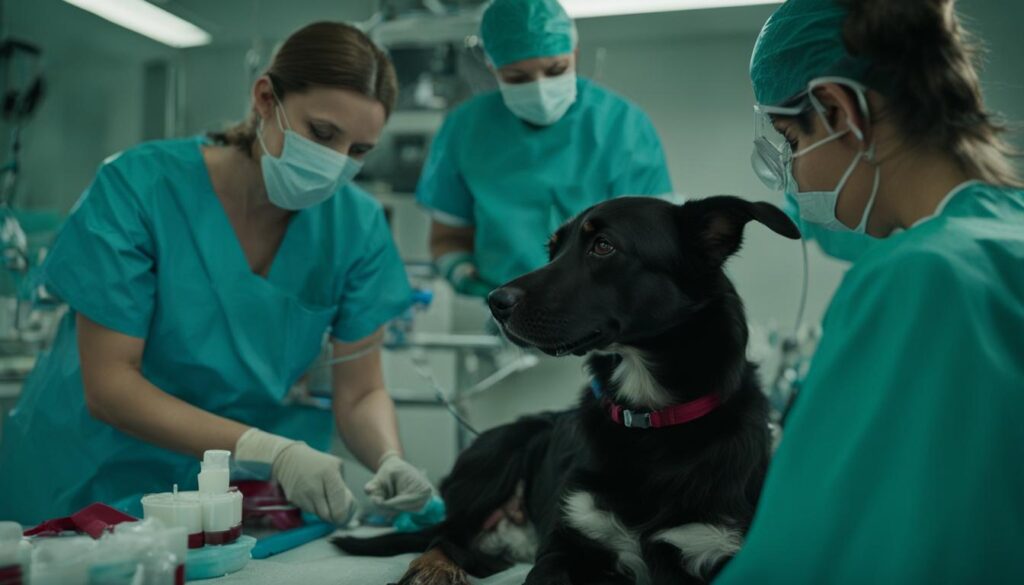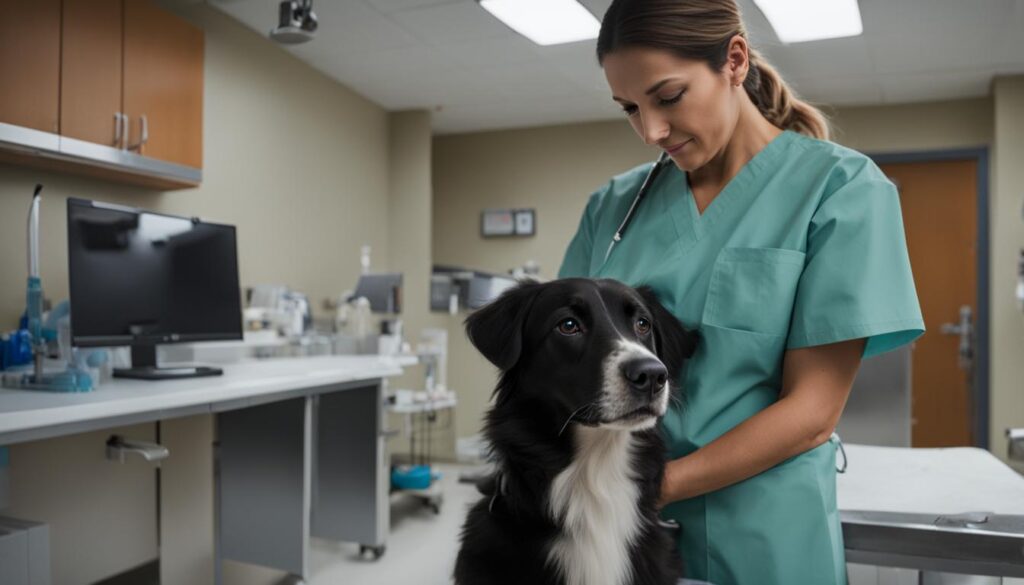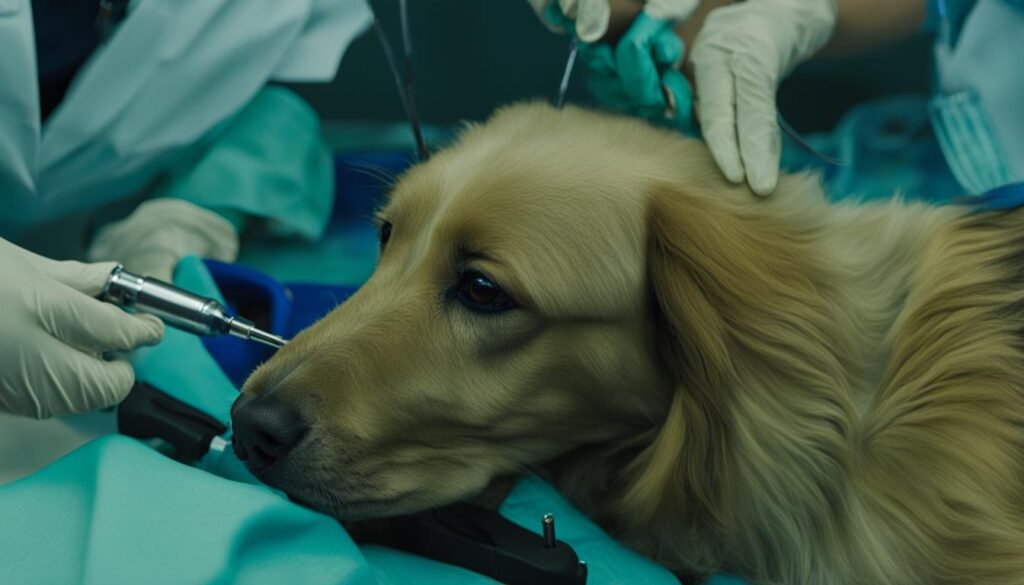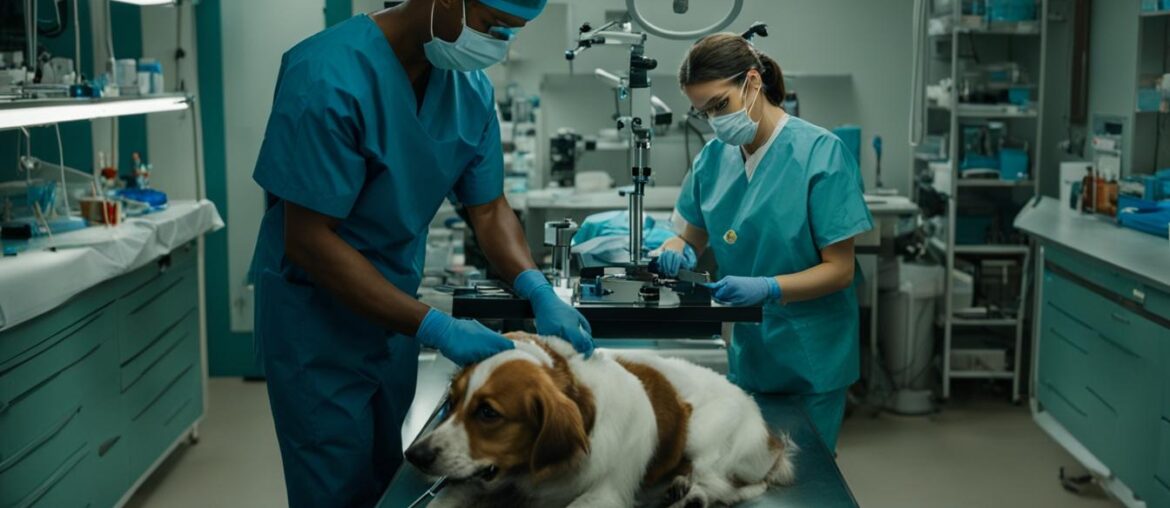When it comes to spaying a dog in heat, many pet owners have concerns and questions. Is it safe? What are the risks involved? Can the procedure be performed during the heat cycle? As a professional journalist specializing in veterinary topics, I’ll provide you with essential vet advice to help you make an informed decision for your furry companion.
Spaying a dog in heat is technically possible, but it may come with increased risks and complications compared to spaying a non-heat dog. During the heat cycle, the female dog’s body undergoes hormonal changes, accompanied by increased blood flow to the reproductive organs. These factors can pose challenges during the spaying process, potentially leading to excessive bleeding, swelling, and other complications.
It is generally recommended to wait until after the heat cycle is over to spay a female dog. This allows the reproductive organs to return to their normal state, reducing the risks associated with surgery. However, skilled veterinarians can adapt their techniques and take precautions to perform the procedure safely even during the heat cycle.
Key Takeaways:
- Spaying a dog in heat is possible but carries increased risks and complications.
- It is generally safer to wait until after the heat cycle to spay a female dog.
- Skilled veterinarians can perform the procedure safely during the heat cycle, but precautions must be taken.
- The hormonal changes and increased blood flow during heat can make the surgery more challenging.
- Always consult with a veterinarian to make the best decision for your dog’s health.
Spaying a Dog in Heat: Controversy and Changing Attitudes

In the past, spaying a dog in heat was a controversial procedure within the veterinary community. However, attitudes have changed over the years, and now spaying during heat is relatively common. Research and advancements in surgical techniques, as well as access to information through the internet and social media, have contributed to this growing acceptance. While there are still potential risks and increased complexity when spaying a dog in heat, skilled veterinarians can ensure the same safe outcomes as with spaying a non-heat dog.
One of the factors that led to the change in attitudes towards spaying a dog in heat is the understanding that waiting until the heat cycle is over may not always be practical or feasible. In certain situations, such as preventing unwanted pregnancies or managing medical conditions, spaying a dog in heat might be the most appropriate choice.
I spoke with Dr. Sarah Johnson, a renowned veterinarian with over 20 years of experience, about the evolving perspectives on spaying a dog in heat. She emphasized the importance of considering the individual dog’s health and consulting with a skilled veterinarian to make an informed decision. Dr. Johnson noted, “While spaying a dog in heat does come with increased risks, it’s essential to weigh those risks against the potential benefits and the urgency of the situation.”
Awareness and education have played a crucial role in changing the perception of spaying a dog in heat. Pet owners now have access to a wealth of information online, enabling them to make more informed decisions about their dog’s health. Veterinary organizations and professionals also actively promote the importance of spaying to prevent unwanted litters and reduce the risk of certain health issues.
Let’s further explore the insights provided by veterinary experts regarding the risks, surgical considerations, and alternatives related to spaying a dog in heat.
| Pros of Spaying a Dog in Heat | Cons of Spaying a Dog in Heat |
|---|---|
| Prevents unwanted pregnancies | Potential risks of excessive bleeding |
| Eliminates the risk of pyometra | Possible infection |
| Reduces the risk of mammary cancer | Swelling or bruising of the abdomen |
| Eliminates the hassle of managing heat cycles | Increased pain or discomfort |
| Delayed wound healing | |
| Suture reaction or dehiscence | |
| False pregnancy |
Veterinary Insights on Spaying a Dog in Heat

According to veterinary experts, there is no solid evidence to suggest higher complication rates when spaying a dog in heat. With proper surgical technique, the outcome is expected to be the same as with a non-heat spay. However, spaying a dog during heat may require more time and suture materials, and the surgeon must be skillful in handling the vascularity of the uterus and delicate tissues. It is generally preferred to spay a dog when she is not in heat, but if necessary, the procedure can be safely performed during heat.
Surgical Considerations for Spaying a Dog in Heat

When it comes to spaying a dog in heat, there are certain surgical considerations that veterinarians must take into account. The swollen uterus and delicate tissues require extra care to avoid complications such as excessive bleeding or accidental tearing. Skilled veterinarians are well-equipped to adapt their surgical techniques, ensuring a successful spay despite the hormonal changes and increased blood supply during heat.
In order to perform a spay on a dog in heat, the surgical procedure may take slightly longer and require additional suture materials compared to a non-heat spay. Attention to detail and precise handling of the swollen reproductive organs are crucial to minimizing the risk of complications. With the expertise of the veterinarian, the outcome of spaying a dog in heat can be as satisfactory as spaying a non-heat dog.
It is important to note that each case is unique, and the decision to spay a dog in heat should be made in consultation with a skilled veterinarian. While there may be potential risks involved, a qualified veterinarian can evaluate the individual dog’s health and determine the most optimal timing for the spay procedure. The focus remains on ensuring the best outcome for the dog’s well-being.
Benefits of Spaying a Dog Before the First Heat Cycle
Spaying a female dog before her first heat cycle offers numerous benefits for her overall health and well-being. By undergoing the procedure early, you can minimize the risks associated with reproductive health issues and enjoy a more convenient and worry-free experience as a dog owner.
Reduced Risk of Mammary Cancer
One of the significant advantages of spaying your dog before her first heat cycle is the reduced risk of mammary cancer. Research has shown that spaying before the first heat can significantly decrease the likelihood of developing this potentially life-threatening disease. In fact, the risk decreases by 99.5% compared to intact dogs.
Prevention of Emergency Surgeries
Spaying your dog before her first heat also eliminates the possibility of emergency surgeries. Conditions like pyometra, a severe infection of the uterus, can occur during or after the heat cycle and require immediate medical attention. By spaying your dog early, you can avoid the need for such emergency interventions and potentially save your dog from a life-threatening situation.
Elimination of Heat Cycle-Related Challenges
Managing a dog’s heat cycles can be challenging for both the dog and the owner. Female dogs in heat experience vaginal bleeding and discharge, which can be messy and inconvenient to deal with. Additionally, male dogs in the vicinity may become more aggressive or persistent in their attempts to mate. By spaying your dog before her first heat, you can eliminate these challenges entirely and create a more relaxed and comfortable environment for your furry friend.
| Benefits of Spaying a Dog Before the First Heat Cycle | |
|---|---|
| Reduced risk of mammary cancer | 99.5% decreased risk compared to intact dogs |
| Prevention of emergency surgeries | Eliminates the risk of conditions like pyometra |
| Elimination of heat cycle-related challenges | No more dealing with messy bleeding or unwanted attention from male dogs |
Alternatives to Spaying a Dog in Heat
If spaying a dog in heat is not feasible or recommended, there are alternatives to prevent unwanted pregnancies. One option is to wait for the heat cycle to end before scheduling the spay surgery. Another alternative is administering medication to temporarily stop the heat cycle. However, medication can have side effects and does not prevent ovulation, so caution should be exercised with these alternatives.
While waiting for the heat cycle to end may seem like a simple solution, it is important to remember that a dog in heat becomes more attractive to male dogs, increasing the risk of unwanted pregnancies. Therefore, careful management and supervision are crucial during this period.
If the decision is made to use medication to temporarily stop the heat cycle, it is essential to consult with a veterinarian to determine the most appropriate medication and dosage. It is also important to closely monitor the dog for any adverse reactions or complications while on the medication.
Ultimately, the choice of whether to pursue alternatives to spaying a dog in heat should be based on careful consideration of the individual dog’s health, the level of risk associated with the alternatives, and the availability of proper management and supervision to prevent unwanted pregnancies.
Laparoscopic Spay as an Alternative for a Dog in Heat

Laparoscopic spay, a minimally invasive surgical technique, can be considered as an alternative for spaying a dog in heat. This approach utilizes small incisions and specialized instruments to remove the ovaries, offering several benefits compared to traditional open surgery.
Firstly, laparoscopic spay provides improved visualization for the surgeon, allowing for enhanced precision during the procedure. This is especially advantageous when dealing with delicate reproductive organs, as it allows for better identification and preservation of surrounding tissues.
Additionally, laparoscopic spay results in decreased tissue trauma due to the smaller incisions, which can lead to reduced post-operative pain, faster recovery, and less visible scarring. This can be particularly important for dogs in heat, as the increased blood flow and hormonal changes during this period can potentially exacerbate post-operative discomfort.
However, it is crucial to note that laparoscopic spay requires specialized equipment and expertise. Not all veterinary clinics may have the necessary resources or trained personnel to perform this procedure. Therefore, it is essential to consult with a veterinarian who is experienced in laparoscopic surgery to determine if this option is suitable for your dog.
The success of laparoscopic spay for a dog in heat may also vary depending on the experience level of the surgeon. If considering this alternative, it is advisable to seek out a veterinarian who has a demonstrated proficiency in laparoscopic techniques.
Overall, laparoscopic spay can be a viable alternative for spaying a dog in heat, providing the benefits of improved visualization, decreased tissue trauma, and potentially reduced discomfort during the recovery process. However, it is important to weigh the availability of this procedure, the expertise of the surgeon, and the specific needs of your dog when making a decision.
Understanding the Risks of Spaying a Dog During Heat

Spaying a dog during heat can pose certain risks that pet owners should be aware of before making a decision. These risks include:
- Excessive bleeding
- Infection
- Swelling or bruising of the abdomen
- Increased pain or discomfort
- Delayed wound healing
- Suture reaction or dehiscence
- Possibility of false pregnancy
These risks are primarily due to the hormonal changes and increased blood supply to the reproductive organs during the heat cycle. It is important to carefully consider these potential risks and consult with a skilled veterinarian before deciding to spay a dog in heat.
Expert veterinary advice can help pet owners weigh the benefits and risks associated with spaying a dog in heat versus waiting until the heat cycle is over. By understanding the potential complications, pet owners can make an informed decision that prioritizes the health and well-being of their furry companions.
Making an Informed Decision on Spaying a Dog in Heat
When considering whether to spay a dog in heat, it is crucial to weigh the potential risks and benefits and make an informed decision. Several factors should be taken into account, including the individual dog’s health, the skill level of the veterinarian, and the timing for spaying a dog in heat. Additionally, considering alternative options and the ability to provide appropriate post-operative care is essential for the dog’s well-being.
The urgency to prevent unwanted pregnancies is a significant factor to consider when deciding to spay a dog in heat. If there is a high risk of accidental mating or complications associated with pregnancy, spaying during heat may be necessary. However, if the urgency is less critical, waiting until after the heat cycle can minimize the risks and potential complications.
Alternative options to spaying a dog in heat should also be explored. Waiting until the heat cycle has ended before scheduling the spay surgery is a viable option to reduce the risks associated with heat. Additionally, medication can be administered to temporarily stop the heat cycle, although this option may have side effects and does not prevent ovulation entirely. Discussing these alternatives with a veterinarian can help determine the best course of action for each individual dog.
It is essential to consult with a skilled veterinarian who has experience performing spays on dogs in heat. Discussing the specific circumstances and considerations surrounding the dog’s heat cycle and overall health can provide valuable insights into the risks and potential complications involved. The veterinarian can provide guidance on the best timing for spaying a dog in heat and address any concerns raised during the consultation.
By carefully weighing all these factors and consulting with a veterinarian, an informed decision can be made regarding spaying a dog in heat. The key is to prioritize the dog’s health and well-being while minimizing risks. Every dog is unique, and the decision should be made based on individual circumstances and professional advice.
Wrapping Up
Spaying a dog in heat is a possibility, but it is important to be aware of the increased risks and complications compared to spaying a dog that is not in heat. While there is no concrete evidence to suggest higher complication rates, the hormonal changes and increased blood supply during the heat cycle can make the surgery more challenging.
In order to minimize the risks, it is generally recommended to wait until the heat cycle is over before proceeding with the spaying procedure. This allows the dog’s body to return to a more stable state and reduces the likelihood of post-operative complications such as excessive bleeding and swelling.
However, should the need arise to spay a dog in heat, it is crucial to consult with an experienced veterinarian who can adapt their surgical techniques to ensure a safe procedure. Their expertise and skill in handling the unique challenges posed by a dog in heat can help minimize the risks involved.
Ultimately, the decision to spay a dog in heat should be made in consultation with a skilled veterinarian, taking into consideration the individual dog’s health, the timing of the procedure, and the potential risks and benefits involved. Prioritizing the well-being of the dog and seeking professional guidance will ensure the best possible outcome for their long-term health.
FAQ
Can you spay a dog in heat?
Yes, it is technically possible to spay a dog in heat. However, it is generally safer to wait until after the heat cycle is over.
Is spaying a dog in heat a common procedure?
Spaying a dog in heat used to be controversial, but attitudes have changed, and it is now relatively common.
Are there higher complication rates when spaying a dog in heat?
There is no solid evidence to suggest higher complication rates, but the surgery may be more complex due to the hormonal changes and increased blood flow during heat.
Are there modifications in surgical technique when spaying a dog in heat?
Yes, the surgeon must take extra care with the swollen uterus and delicate tissues. The procedure may take longer and require more suture materials.
What are the benefits of spaying a dog before the first heat cycle?
Spaying before the first heat reduces the risk of mammary cancer and eliminates the need for emergency surgery for conditions like pyometra or unwanted pregnancy.
What are the alternatives to spaying a dog in heat?
Alternatives include waiting for the heat cycle to end before scheduling the spay surgery or administering medication to temporarily stop the heat cycle.
Is laparoscopic spay an option for a dog in heat?
Laparoscopic spay can be considered as an alternative for a dog in heat, but it requires specialized equipment and expertise.
What are the risks of spaying a dog during heat?
Risks include excessive bleeding, infection, swelling, increased pain or discomfort, delayed wound healing, suture reaction or dehiscence, and the possibility of false pregnancy.
How can I make an informed decision on spaying a dog in heat?
Consider the individual dog’s health, consult with a veterinarian, and weigh the potential risks and benefits before making a decision.
Can you provide a summary of spaying a dog in heat?
Spaying a dog in heat is technically possible but comes with increased risks and complications. It is generally safer to wait until after the heat cycle is over, but skilled veterinarians can adapt their surgical techniques to ensure a safe procedure.






